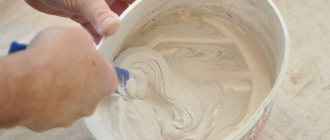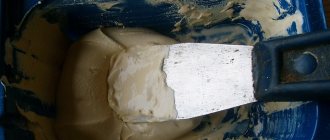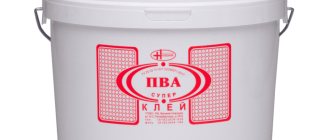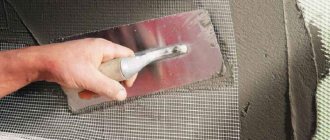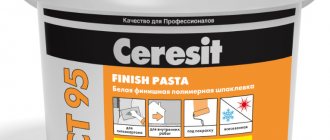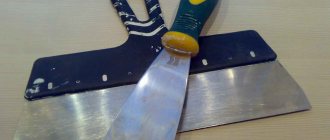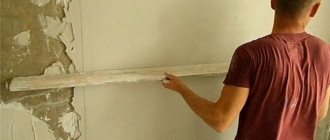How to apply primer to walls?
The primer is an adhesive solution and is intended to bond the surface of the base coat before applying adhesives to it.
A sure confirmation that the wall is ready for finishing work is the absence of any fractions falling off from it when carrying some hard object over the surface of the plaster; otherwise, finishing work cannot be carried out. Primer is performed before :
- Plastering with a cement-sand mixture;
- Starting putty;
- Wallpapering.
Thus, the priming process will be carried out three times , with two layers each time, but the same tool can be used.
For priming in open areas, use a roller , and in the corners use a square brush. First you need to treat these areas, generously going over the joints with the bristles of the brush, but in subsequent times you don’t have to do this.
The primer solution must be poured into a plastic tray and the roller must be periodically wetted in it; before rolling it on the wall, excess liquid must be removed , since it has a low density and if there is excess, it will flow off the pile. After the first layer has dried, perform the second in the same way.
How to dilute primer for walls?
It must be said that although the primer is not the most expensive component of the repair, however, when finishing a large area you will need quite a lot of , especially when preparing the plastered surface for putty; as you know, the cement-sand mixture perfectly absorbs moisture.
That is why many and even experienced plasterers practice diluting the solution with water , but in what cases can this be done and in what way?
If the primer is concentrated, which is done for ease of transportation, then it is not only possible, but also necessary , this is done in the proportion indicated on the packaging. For a regular primer, it all depends on the manufacturer and the surface being treated.
The recommended proportion is one part water to two parts soil, but the necessary condition is that the solution must be used immediately and all of it, since by the next day its quality will deteriorate significantly.
dilute the soil applied to a concrete wall under plaster or putty under wallpaper, but it is not recommended to use plaster under putty, since the cement-sand mixture absorbs moisture quite well, and due to the weak content of binders, it can begin to peel off.
Dilute the mixture
Acrylic primers are component compositions. The technology of their dilution depends on this. For such purposes, experts recommend using several substances:
- The optimal thinner will be a special acrylic mixture that is compatible with a particular brand. Often, such solutions are recommended by the manufacturers of these products.
- Water. This mixture can only be used in cases where the soil contains a similar component. Water-acrylic mixtures are often diluted.
Some users recommend using a special thinner 647. But this issue is controversial, since the use of this product depends on the properties of the selected primer.
The amount of thinner often does not exceed 25% of the total volume of the mixture. Please note that it is important here to also consider the amount of hardener that is added to the solution when mixing.
You can find out the exact proportions and recommended solvent on the packaging. It is important to follow all basic recommendations to obtain high-quality and durable protection.
How to replace primer for walls?
Sometimes, for some reason, there is not enough primer, and if a small area of the surface remains to be treated, then visiting the store is not advisable, and in this case, various methods of replacing the primer composition .
The main purpose of the primer is to hold the surface together so that it does not “crumble,” which means that the replacement product should have similar properties. It is necessary to keep in mind that no substitute will be better or cheaper than primer, so it is better to still find an opportunity to purchase this material.
Benefits of priming
A primed surface has many advantages:
- the finishing material is applied very easily and with high quality;
- the service life of the finish is significantly extended;
- deeply penetrating compounds significantly reduce the porosity of walls, strengthen them and protect them from crumbling;
- the primed surface practically does not wear out, the mixture provides effective protection against corrosion for many years;
- hides and corrects minor defects on walls or ceilings;
- the mixture is very good for painting, varnishing and puttying; thanks to the correctly selected product, the consumption of finishing material for finishing is significantly reduced;
- if there are antiseptic additives in the soil, then the surface becomes disinfected, mold and fungi do not appear on it, and various microorganisms and pests do not appear.
Why is surface priming required?
So what is this for?
Further finishing materials will be applied to pre-primed surfaces much better.- The primer composition will extend the life of the coating.
- A deep-permeable primer helps to regulate the porosity of the base and also make it stronger.
- Once applied, the primer will prevent wear and tear on the materials and will also help protect them from the surface.
- Concealment of small flaws.
- Primers for puttying, painting, and varnishing help greatly reduce the consumption of finishing materials.
Now let's look at what is important to use as a dilution agent.
How to dilute it?
Many of those who purchase a mixture for surface treatment are wondering: what and how to dilute the primer for painting or putty? It all depends on the type of product purchased; strengthening mixtures and primers that increase adhesion are now sold. The composition includes the following materials:
- acrylic, they are also called emulsion or dispersion. They are universal, because they are used for any type of walls, floors and ceilings, but they cannot be used for metal processing, they do not have anti-corrosion components. To dilute this type of primer, you can use plain water. Acrylic products are non-toxic and most often do not have any odor. To properly dilute this primer, only consult the seller or read the instructions on the package, however, often acrylic strengthening mixtures and deep penetration are diluted with plain water;
- alkyd primers are most often used for application to wooden products and any wood substrates for painting. Thanks to deep penetration, these compounds provide excellent adhesion of wood and paints. They are also used for applying to various metals, but they should not be used on concrete and brick buildings. How to properly dilute this type of primer? Usually the same solvent that is included in this primer is used, but other solvents can be used, for example, solvent or white spirit;
- Polyurethane and epoxy compounds are used to treat concrete walls or ceilings, and they are used for painting. Some of these products can be used to protect metal from rust, after which the products are painted with enamel. How should this primer be diluted for walls and other surfaces? As a solvent, you can use xylene or some other universal solvent, which should be approximately 5-10 percent, no more;
- polystyrene primers are used for application to plastered or wooden walls; these primers are toxic, so you need to wear personal protective equipment and ensure that there is sufficient ventilation in the room while working. It is advisable to use for external, facade walls. To dilute this type of primer, you must follow the instructions, which will indicate which solvent should be used;
- Metal processing mixtures consist of different components that can transform rust and create an insulating or protective layer. These concentrates must be properly diluted using the manufacturer's recommended diluent, the volume of which should be a maximum of 10 percent of the volume of the mixture. These soils cannot be diluted with water. Universal thinners are most often used;
- perchlorovinyl preparations are used to treat façade brick and concrete walls. They are often sold ready-to-use and do not require dilution. However, with increased viscosity, you can use organic solvents, solvent or xylene, which is usually included in these products.
What to use as a thinner
Primers vary in composition, properties, and application. Moreover, they are all divided into two types - strengthening and increasing adhesion.
- Acrylic is also called dispersion or emulsion. We can say that it is universal, since it is used for almost all types of surfaces of walls, floors, ceilings, but is not used on metal, since it does not have anti-corrosion properties. Acrylic concentrate can be diluted with water. The substance is non-toxic and odorless. Acrylic can be either an adhesive primer or a deep penetration primer.
- Alkyd is used more for preparing wooden walls, floors and other substrates for further painting. Due to deep penetration and loosening of the top layer of wood, the primer mixture will ensure better adhesion of the base and paint. Used under enamel and for metal work. But it is not recommended for use on walls made of stone, concrete and other minerals. This also includes anti-corrosion alkyd mixtures with a rust modifier. The concentrate can be reduced with the same organic solvent as in the mixture, or use white spirit, xylene, solvent, or mixtures thereof.
Alkyd primer is more suitable for metal than stone, concrete, etc. - Epoxy and polyurethane are used to treat concrete bases of walls, floors, ceilings, and under enamel. Also, certain mixtures are designed for working on metal (anti-rust) with subsequent enamel coating. To simplify application and lengthen the start time of polymerization, xylene (5-10% by volume) or other universal liquid is suitable as a solvent.
- Polystyrene is used for walls - on plaster and wood. The substance is toxic. Requires compliance with personal protective measures, as well as good ventilation of the premises during work and during the drying period. It is safest to use in the intermediate finishing of external walls of a building.
- Primers for metal work are generally classified as a separate group. The composition may contain various substances responsible for the special properties of the material: insulation, protection, transformation. The concentrate is diluted with various solvents up to 10% of the total volume, but not with water. The types of “native” organic solvents or universal ones are mainly used. Priming of metal structures in several layers is mandatory for enamel, painting and in conditions of constant humidity.
- insulating, protecting against moisture penetration and rust formation - glypthal, phenol-formaldehyde compounds. Form a durable, waterproof film;
- protective (passivating) - make iron immune to the influence of aggressive environments, that is, increase its insulation;
- transformative - convert rust into a poorly soluble or quickly destructible compound, increase the adhesive properties of materials.
- Perchlorovinyl is intended for treating external walls made of concrete and brick. Typically, such compositions have a normal working consistency. The composition contains an organic solvent (xylene or solvent), which is also used to dilute it if it is too viscous.
The diluted primer mixture adheres better and sets faster. However, deep-penetrating oil performs better when undiluted.
Experts recommend that when performing intermediate construction and repair work, priming must be done. In turn, manufacturers of building mixtures made sure that the client could use the material without problems, providing the packaging with instructions for use.
Conclusion
Experts advise to be sure to use the appropriate type of primer product when performing repair or finishing work. When applying several layers of primer, the surface will be durable and the finish will last much longer. To dilute primer compositions, you can follow the information from this article; in addition, you can consult an experienced seller, and also be sure to read the instructions for use of the product and use exactly the type of thinner in the required proportion that the manufacturer recommends.
Modest on the outside, but so important on the inside. We are talking about the primer mixture and its powerful functions. Thanks to it, wall and ceiling coverings hold up well and look great.
Process Details
What to use as a thinner
Primers can be distinguished by properties, composition, and also method of application. Moreover, all of them can be divided into two types - increasing adhesion (that is, adhesion) and strengthening.
- Acrylic primer is also called emulsion or dispersion primer. You can also say that it is universal, because it is used for almost all types of surfaces of the floor, walls, ceiling, but they are not used for metal processing, because the product does not have anti-corrosion properties. Acrylic concentrates can be diluted with water. The substance is non-toxic and has no aroma. An acrylic primer can be either an adhesive type or one with deep penetration.
- Alkyd primer mixture is used more to prepare wooden walls, floors and other substrates for further painting. Due to the deep type of penetration, as well as loosening the top layer of wood, the primer mixture will provide excellent adhesion of the base, as well as the paint and varnish material. It is used under enamel and for work on metal surfaces.
But it is not recommended to use it on wall surfaces made of concrete, stone and other types of minerals. This will include anti-corrosion alkyd compounds with a rust modifier. The concentrate can be reduced with similar organic solvents as in the mixture, or white alcohol, solvent, xylene and mixtures thereof can be used.
Polyurethane and epoxy are used to treat concrete base floors, walls, ceilings and under enamel. Some other mixtures are intended for work on metal (anti-corrosion) with further enamel coating. The primer can be diluted with xylene (from 5 to 10% of the total volume) and then coated with enamel. This is necessary to simplify application and increase the start time of polymerization.- Polystyrene primer mixture is used for wall surfaces - wood and plaster. The substance is very toxic and requires compliance with personal protection measures, as well as excellent ventilation of the room during work and during drying. It is safest to use the product in the intermediate finishing of external building walls.
- Primer compositions for metal work are generally identified as a separate group. The composition may contain various substances that are responsible for the special properties of the material - protection, insulation and transformation. The concentrate is diluted with various solvents up to 10% of the main volume, but not only with water. The types of “native” solvents of organic or universal types are mainly used.
Priming of metal structures in several layers is mandatory under enamel, painting or in conditions of constant moisture. These are insulating agents that protect against moisture and rust - glypthal and phenol-formaldehyde compounds. They help form a durable and waterproof film. There are also protective (that is, passivating) ones, which make iron immune to the effects of negative environments, namely, increases its insulation. And the third type is transformative, which converts rust into a poorly soluble or quickly destructible compound, and also increases the adhesion properties of materials
.
- Perchlorovinyl priming liquid is intended for the treatment of external walls made of bricks and concrete. Typically, such compositions have an excellent working consistency. The composition contains organic types of solvents (solvent or xylene), and they are also diluted with it if it is already very viscous.
Advice
A primer mixture that is diluted applies much better and sets faster.
And, nevertheless, deeply penetrating compositions perform best in undiluted form. Experts strongly recommend that when carrying out intermediate construction and repair work, priming must be carried out. In turn, companies that manufacture building mixtures are concerned that customers can use the material without any problems, providing the packaging with instructions for use.
When to apply primer
How to properly apply primer to walls and ceilings, how to prime correctly
To ensure that the final coating of wall and ceiling materials looks its best, you should adhere to several points and recommendations.
Does it need to be diluted with water?
If we are talking about a ready-made mixture, just stir it well. The concentrate requires the addition of water. The ratio of soil impregnation to water is two to one, but usually the manufacturer specifies this on the packaging individually for its product.
How to properly apply primer to walls and ceilings, how to prime correctly
To ensure that the final coating of wall and ceiling materials looks its best, you should adhere to several points and recommendations.
Does it need to be diluted with water?
If we are talking about a ready-made mixture, just stir it well.
The concentrate requires the addition of water. The ratio of soil impregnation to water is two to one, but usually the manufacturer specifies this on the packaging individually for its product. The resulting solution must be used on the same day, as it will then become unusable.
Which roller is better to choose?
The store offers a wide range of rollers. Practical experience shows which of them work better and more conveniently in a given situation.
The roller consists of a handle with a holder and a roller. It is customary to choose a durable handle so that the tool will last for many years. The roller with a “coat” of foam rubber, fur, or velor wears out over time and requires replacement.
Foam rubber is used to apply a mixture of thick consistency. Fur is considered universal; it is suitable for both thick and liquid mixtures. The desired pile length is 15 mm.
Velor also copes with liquid and thick compounds. The pile of this type of roller does not exceed 5 mm, so they should only be used to prime smooth surfaces.
In hard-to-reach places (behind pipes, radiators, in corners, junctions), where you need to carefully apply primer, it is convenient to work with a special angled roller or brush.
Which roller is better for priming faster?
For an accelerated pace of work, you should use a fur roller and a handle extension with a telescopic design.
Do I need to wash the walls?
Before directly applying the primer coat, make sure that the area to be treated is free of dirt and dust. It is enough to go over it with a simple spatula and then with a damp sponge.
How many layers need to be applied
The number of layers applied depends on the degree of unevenness of the walls and ceilings. Experts recommend priming in two layers to achieve a high-quality result. Moreover, after each layer, be sure to let the coating dry.
Application
First you need to correctly decide on the choice of primer mixture. It depends on:
- surface smoothness/porosity;
- type of finishing material.
It doesn’t matter at all whether the walls or ceiling need to be impregnated; in this regard, there is no separation.
The work process cannot be called complicated. For convenience and the best result, you need to use a special tray - a paint bath, into which you should pour part of the construction impregnation. A roller soaked in the composition is rolled out over the tray, squeezing out the excess. This is a mandatory condition so that during processing the liquid mixture does not drain from the surface.
The primer must be applied in a thin layer to avoid pooling. First, you should impregnate the corners and junctions, then the main surfaces.
Popular primers
The primer mixture is divided into 3 types:
- dye;
- deep penetration agent;
- concrete contact.
The paint is used on a smooth and even base. For porous, rough and moisture-absorbing areas, deep penetration coatings are used. Concrete contact is applied under decorative plaster.
Acrylic primer impregnation is suitable for concrete, brick, drywall and stone. For wooden and metal bases - alkyd. Brick and external plaster are treated with silicate.
Top sellers are Ceresit CT 17, Tiefgrund LF D 14, Bindo Base, Acton, Opti Grund ELF
When can painting and gluing be done?
After applying the composition, the walls and ceiling must dry completely.
During this period, all repair work must be suspended to ensure the surface remains clean. Drying time depends on the type of base, humidity and room temperature, sometimes it takes 4 hours, and sometimes the whole day. If the place where the product is applied no longer sticks to your hands, it’s time to finish it with facing materials. A primer is necessary for high-quality repairs and durability of the result. Neglecting this procedure will lead to surface defects and imperfections, which will become visible to the naked eye after final finishing. In addition to the ideal appearance, the walls and ceiling will strengthen their strength characteristics and mold will not appear on them.



